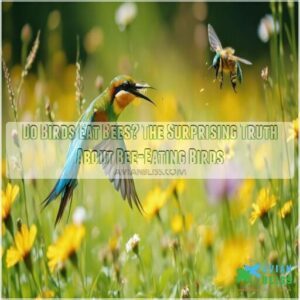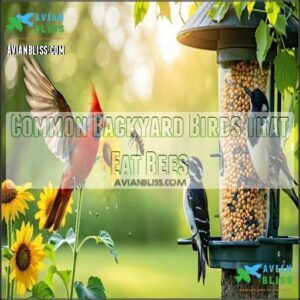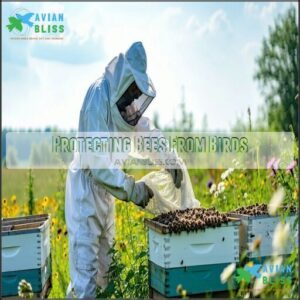This site is supported by our readers. We may earn a commission, at no cost to you, if you purchase through links.

Bee-eaters, aptly named for their diet, are specialists found in warmer regions.
Other birds, like barn swallows or sparrows, may take bees opportunistically if they’re hungry and the insects are nearby.
To handle the sting risk, many bird species have learned to catch and kill bees midair with precision, then wipe the stinger off before swallowing.
This behavior might seem bold, but for birds, it’s just another meal.
Curious how they’ve adapted to such a challenging snack? The details are more fascinating than you’d think, and understanding this behavior is key to appreciating these birds.
Table Of Contents
Key Takeaways
- Birds like bee-eaters and tanagers eat bees regularly, using clever techniques to remove stingers for safe consumption.
- Opportunistic feeders, such as sparrows or woodpeckers, include bees in their diets when available and adapt based on the season.
- Birds eat bees for their high protein content, and some target non-stinging male drones or even dead bees as a snack.
- Specialized hunters like bee-eaters have sharp beaks, venom resistance, and precise skills to handle stinging prey efficiently.
Birds Eating Bees Overview
You might be surprised to learn just how many bird species include bees in their diets.
From specialized hunters like bee-eaters to opportunistic feeders, birds have fascinating strategies for catching and consuming these stinging insects.
Types of Birds That Eat Bees
Some birds specialize in hunting bees, like bee-eaters and summer tanagers, showcasing remarkable dietary adaptations.
Opportunistic feeders, such as robins and woodpeckers, also include bees in their diet when available.
Backyard avian predators demonstrate nature’s fascinating balance, with diverse insectivorous birds relying on bees as a key food source, and some, like northern cardinals, snack on bees occasionally during warmer months, highlighting the diverse insectivorous nature of these birds.
Regional Variations in Bee-Eating Birds
Why do bees face such varied fates worldwide?
Eastern, Western, Northern, and Southern bee-eaters showcase interesting regional variations, shaped by habitat and insect availability.
In Europe, bees dominate diets, while Australia’s rainbow bee-eaters thrive on diverse flying insects.
North America lacks true bee-eaters, though many birds eat bees opportunistically.
Habitat influence truly defines how these birds balance their meals.
Adaptations for Bee Hunting
From sharp beaks to nimble movements, bird adaptations for hunting bees are astonishing.
Some species, like bee-eaters, display specialized hunting morphology, using their beaks for precise stinger removal, while others develop venom resistance.
With keen visual acuity, they spot prey mid-flight.
Digestive adaptations also help process tough bee exoskeletons, proving their hunting techniques are as versatile as they’re impressive.
These adaptations are critical for survival, especially considering habitat loss threats, and are a testament to their hunting techniques and ability to thrive in challenging environments with specialized hunting morphology.
Do Birds Eat Bees
It might surprise you, but yes, birds eat bees.
Birds eating bees showcase nature’s balance, blending survival strategies with fascinating adaptations for handling stingers and thriving on nutritious prey.
Some specialize in bee consumption, while others include bees as part of their diet alongside other insects.
Why do birds prey on bees?
They’re a nutritious snack packed with protein.
Bee-eating birds, like Summer Tanagers, even have fascinating hunting behaviors to handle stingers.
Here are five facts about birds eating bees:
- Bee diets differ: Birds like bee-eaters consume mostly bees; others eat them occasionally.
- Bird adaptations include specialized behaviors to avoid stings, such as shaking bees to remove venom.
- Some, like kingbirds, prefer stingless male drones.
- Bee consumption peaks in seasons with more flying insects.
- Stinger avoidance techniques allow birds to eat bees safely without harm.
Bee-eating is nature’s balance in action!
Birds that consume insects are considered insectivores with high metabolism.
Bee-Eating Bird Species
You’ll find that many bird species have developed unique ways to include bees in their diets.
Many birds have mastered the art of safely eating bees, showcasing incredible adaptations and nature’s remarkable balance.
From backyard visitors like cardinals to global specialists like bee-eaters, each bird has fascinating adaptations for handling these stinging insects.
Common Backyard Birds That Eat Bees
In your backyard, several birds eat bees as part of their diet.
Northern cardinals occasionally snack on bees during warmer months. Purple martins, known for their agile hunting habits, capture bees mid-flight.
Summer tanagers expertly perform stinger removal before eating. Woodpeckers burrow into tree trunks for larvae, while mockingbirds balance fruit and insect consumption, proving birds eating insects is common.
**Attracting cardinals with sunflower seeds can bring these birds to your yard.
Bee-Eating Specialists Around The World
Global bee-eaters, like those in the Merops genus, thrive across Europe, Africa, and Asia, showcasing specialist adaptations for hunting bees.
Honey Buzzards focus on larvae, while tanager variations and kingbird diets highlight diverse tactics among bee-eating birds.
These insectivorous birds demonstrate precise techniques, such as removing stingers or targeting hive areas, emphasizing their pivotal role in balancing ecosystems reliant on birds eating insects.
Opportunistic Insectivores That Eat Bees
Not every bird eating bees fits the “specialist” label.
Many insectivorous birds add bees to their insect diet when opportunity knocks. These opportunists, with dietary flexibility, adjust based on season and habitat influence.
You’ll notice:
- Northern Cardinals snacking on bees in summer.
- Purple Martins hunting bees mid-flight.
- Mockingbirds shifting diets seasonally.
- Magpies targeting grounded bees near hives, which is a key behavior to observe.
Birds Hunting Bees
You might be surprised to learn how many birds have developed precise techniques to catch bees.
From sharp eyesight to strategic perches, these adaptations help them target and avoid the dangers of their stinging prey, using precise techniques to ensure their survival.
Specialized Features for Catching Bees
Bee-eating birds have specialized features for catching bees.
Stinger removal is key—species like bee-eaters beat bees on branches to dislodge stingers. Beak morphology plays a role too, with curved beaks aiding precision.
Some have venom resistance to handle toxic prey.
Digestive adaptations, like gravel consumption in Purple Martins, help process tough exoskeletons.
These traits make their hunting techniques highly efficient.
Hunting Strategies for Different Bird Species
Bird hunting for bees isn’t random—it’s a mix of skill and strategy.
Bee-eating birds like Kingbirds specialize in drone targeting, while Summer Tanagers perfect stinger removal.
Purple Martins use aerial acrobatics to snatch prey mid-flight, relying on precision.
Some birds, like woodpeckers, focus on larvae targeting, showing how varied foraging behavior shapes each bird’s diet and hunting success.
Mindful observation can help birdwatchers better understand bird behavior patterns, which is key to understanding bird behavior.
How Birds Avoid Getting Stung
How do birds eat bees without getting stung?
Their physical adaptations, like tough feathers and scaley legs, act as armor.
Bee eaters master stinger removal by quickly rubbing bees on branches to squeeze out venom.
Instincts & learning guide hunting strategies, ensuring stinging prevention, and clever techniques, like mid-air grabs, highlight how bird hunting handles bee stings with precision and skill.
Protecting Bees From Birds
You can take several steps to protect bees from predatory birds without harming either species.
Bird-proof screens, netting, and careful hive placement are efficient methods to guarantee your bees stay safe.
Using Bird-Proof Screens to Protect Bees
Protecting your bees with bird-proof screens is a smart move.
Choose durable screen material types that minimize bird-bee interactions while supporting pollinators. Installation costs vary, but their effectiveness rate often exceeds 90%.
Be sure to weigh the environmental impact and bird conservation efforts. For effective solutions, consider exploring various screen options.
Alternative deterrents can work, but screens remain a reliable option for safeguarding bees without harming birds, making them a good choice for bee protection.
Installing Netting to Keep Birds Away
Netting can block birds from accessing bee hives without much hassle. Choose durable netting material options, considering cost and environmental impact.
Properly installed netting reduces bird behavior like hive raids while preserving bird-watching moments. For specialized solutions, consider exploring options for bird netting for bees.
Evaluate netting effectiveness duration to balance maintenance and aesthetic considerations. It’s a simple solution to keep bees safe and birds undisturbed in shared environments.
Other Methods for Protecting Bees
Want to keep your garden buzzing safely? There are more ways to shield bees from bird predators and encourage pollination.
- Grow native plants to support bees’ natural defenses.
- Add water sources with shallow edges.
- Reduce pesticide use for healthier habitat preservation.
Consider using protective garden netting to create a physical barrier.
- Support education programs promoting bird-friendly gardens.
- Arrange safe nesting spots to balance bird protection and bee safety.
Frequently Asked Questions (FAQs)
What birds eat bees?
Imagine a buffet in the skies—birds like bee-eaters, summer tanagers, scarlet tanagers, and purple martins savor bees.
Some, like kingbirds, prefer stingless drones, while others, like woodpeckers, even snack on bee larvae.
Who should not consume beets?
If you have kidney stones, low blood pressure, or diabetes, beets mightn’t be for you.
They’re high in oxalates, lower blood pressure, and can affect blood sugar—talk to your doctor to stay safe!
Why do birds eat bees?
Birds eat bees for their high protein and energy content, especially during breeding or feeding seasons.
They’ve adapted to handle stingers by crushing bees or targeting non-stinging drones, ensuring a safe and nutritious meal.
How many species of birds eat bees?
They say nature’s menu has something for everyone—over 20 species of birds include bees in their diets.
From bee-eaters to tanagers, these feathered foragers cleverly handle stingers, showing how resilience fuels survival.
Do birds eat dead bees?
Yes, some birds will eat dead bees, especially opportunistic feeders like magpies or sparrows.
These birds aren’t picky and will scavenge for protein-rich snacks, including deceased bees, when live prey isn’t readily available, which makes them opportunistic feeders like magpies.
Do birds eat wood bees?
Wood bees, like carpenter bees, are fair game for many birds.
Species like woodpeckers and kingbirds will target them, especially in nesting season, often tackling their defenses with clever techniques before enjoying the nutritious snack.
What is the main predator of a bee?
Bees face many predators, but birds, like bee-eaters and tanagers, are top threats.
Other notable predators include wasps, spiders, and mammals like bears, which target hives for honey and bee larvae.
Do birds get rid of bees?
Bold birds bravely beat bees before biting.
Many, like the Summer Tanager, skillfully remove stingers by smashing bees against branches.
This crafty tactic lets them enjoy their meal without getting stung—a clever adaptation in nature, showcasing bold birds’ unique behavior.
What happens if a bird eats a bee?
When a bird eats a bee, it often removes the stinger by beating the bee against a branch first.
If swallowed whole, many birds have digestive systems that can neutralize bee venom effectively.
How do birds eat bees without getting stung?
Birds remove bee stingers by smashing them against branches or carefully grabbing non-stinging males.
Some species, like bee-eaters, use their long beaks to skillfully extract venom, ensuring a safe, sting-free meal.
Conclusion
Regarding whether birds eat bees, the answer is as clear as daylight—they do, and many are incredibly skilled at it.
From bee-eaters with specialized techniques to opportunistic feeders like sparrows, birds have adapted ways to hunt and consume bees safely.
By wiping off stingers and targeting bees mid-flight, they turn a risky meal into an energy-rich snack.
It’s a remarkable balance of nature, showcasing both birds’ ingenuity and the ecosystem’s complexity.
- https://animals.sandiegozoo.org/animals/bee-eater
- https://upload.wikimedia.org/wikipedia/commons/9/92/Food_habits_of_the_swallows_-_a_family_of_valuable_native_birds_%28IA_foodhabitsofswal619beal%29.pdf
- https://meridian.allenpress.com/wjo/article-abstract/135/1/93/490668/The-birds-and-the-bees-Western-Kingbirds-Tyrannus
- https://wilsonsociety.org/2023/04/25/guest-post-why-do-kingbirds-prefer-to-dine-on-drone-bees/











